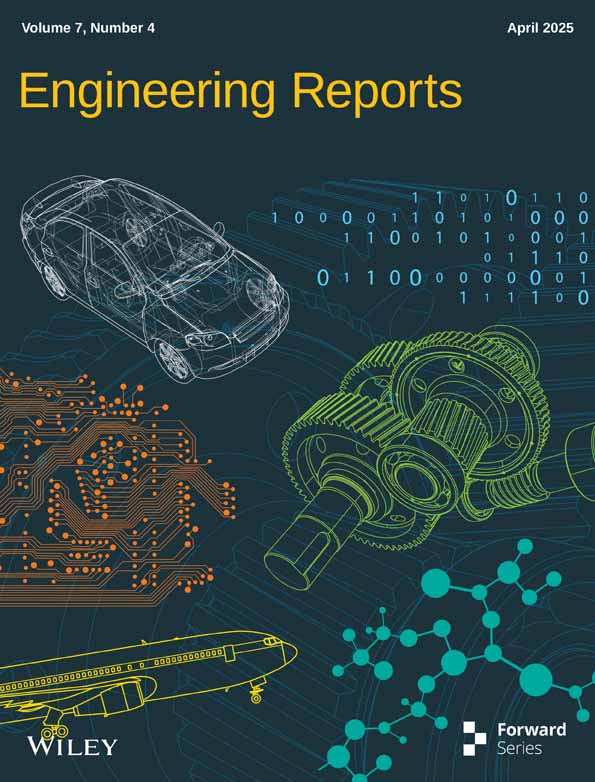Energy Efficiency Comparison of ECBC–2023 and IECC–2021 for Residential Buildings in Different Climate Zones of Pakistan
Funding: The authors received no specific funding for this work.
Muhammad Osama Aziz and Muhammad Abbas contributed equally to this work.
ABSTRACT
This study presents a comparative analysis of the energy-saving potential of the newly developed Pakistani regulation, the Energy Conservation Building Code–2023, and the International Energy Conservation Code–2021 for residential buildings in Pakistan. Utilizing an EnergyPlus-based simulation tool, the energy consumption of a typical house was modeled in three different climate zones of Pakistan: 0B (hot and dry), 3B (warm dry), and 7B (very cold). The analysis focused on evaluating how improvements in the building envelope, as mandated by each code, impacted the overall energy consumption of the building. Results revealed that the Energy Conservation Building Code–2023 performs better than the International Energy Conservation Code–2021 in hot climates such as Karachi. Specifically, the Energy Conservation Building Code–2023 achieved a 24% reduction in annual energy consumption, compared to the 21.8% reduction achieved by the International Energy Conservation Code–2021. However, the International Energy Conservation Code–2021 demonstrates higher energy savings in warm and cold climates (Quetta and Skardu). In these zones (warm 3B and very cold 7B), the International Energy Conservation Code–2021 led to reductions of 47.32% and 79.5%, respectively, compared to 45.3% and 33.86% achieved by the Energy Conservation Building Code–2023. This variation in energy-saving potential is attributed to the stringent U-value standards set by the International Energy Conservation Code–2021, particularly for colder climates. The study evaluates the strengths and limitations of both codes concerning Pakistan's diverse climatic conditions, underscoring the need for region-specific energy conservation standards to optimize residential building efficiency. It highlights the necessity for ongoing Research and Development to enhance the effectiveness and nationwide applicability of the Energy Conservation Building Code–2023.
1 Introduction
The global climate crisis, primarily caused by rising greenhouse gas (GHG) emissions, is a major threat to the environment and human well-being. Addressing this crisis requires urgent action through emission reductions, sustainable energy solutions, and climate adaptation strategies. Nearly 40% of global carbon emissions stem from energy consumption in buildings, primarily due to heating, cooling, lighting, and other operational needs. This highlights the critical role of energy efficiency and sustainable building practices in reducing emissions and mitigating climate change [1, 2]. As more people require housing and infrastructure, the energy demand for heating, cooling, and electricity in buildings rises sharply. While 81% of the world's primary energy comes from fossil fuels [3, 4], transitioning to renewable energy sources alone is insufficient. Implementing stringent building energy codes or regulations to reduce GHG emissions from buildings has also become imperative [5, 6]. Therefore, strict building codes are pivotal in improving energy efficiency in compliance with UN Sustainable Development Goals 7, 11, and 13. Developed countries have recognized the urgency of this issue and are actively implementing stringent building energy codes to enhance energy efficiency in buildings and reduce emissions. One prominent example is the two building codes in the United States, that is, the International Energy Conservation Code (IECC), developed by the International Code Council, and ASHRAE Standard 90.1, developed by the American Society of Heating, Refrigerating and Air-conditioning Engineers (ASHRAE) [5, 7, 8]. Both codes set minimum energy efficiency standards in buildings [9], promoting energy-saving technologies, and sustainable construction practices. Similarly, other developed countries have building energy regulations to ensure the sustainable design, construction, and operation of residential and commercial buildings.
Developing countries, on the other hand, are also beginning to adopt similar measures to curb their growing emissions [10]. Pakistan's building sector is expanding at an uncontrolled rate and is the most energy-intensive sector in the country [11]. To address the rising energy demand in buildings and the associated environmental concerns, Pakistan introduced the Energy Conservation Building Code in 2023 (ECBC–2023) [12]. The ECBC–2023 includes provisions for building envelope and fenestration U-value and Solar heat gain coefficient (SHGC) requirements to minimize heat loss and gain, mandates efficient lighting systems and electrical appliances, and sets standards for heating, ventilation, and air conditioning (HVAC) systems to optimize energy use. Moreover, The ECBC promotes renewable energy integration and water conservation in building design. By enforcing these regulations, ECBC–2023 Pakistan enhances energy efficiency, supporting global climate action and sustainable development.
1.1 Literature Review
Building energy codes and standards play a vital role in improving the energy efficiency of residential and commercial buildings by setting minimum requirements for design, construction, and operation. Global efforts to reduce GHG emissions have driven the development and implementation of such regulations in the building sector. Numerous studies have highlighted the effectiveness of these codes in reducing energy consumption and operational costs in buildings. This subsection reviews relevant research in this domain, focusing on the role of energy codes, comparative studies, and simulation tools to evaluate building energy performance. Building energy codes are well established in developing countries. However, their implementation is still in the early stages. Pakistan, for example, has introduced the ECBC–2023 to address the growing energy demand in buildings and reduce the sector's contribution to GHG emissions [12]. However, studies on implementing energy codes in developing countries reveal challenges and opportunities. One study analyzed the status of building energy regulations in 60 developing countries worldwide, identifying many challenges facing the successful implementation of building energy regulations in the developing world and their implications for energy conservation and efficiency [13]. The barriers to adopting energy codes in Pakistan were explored, identifying challenges such as limited awareness, high upfront costs, and the lack of skilled professionals in energy-efficient building design [14]. Despite these challenges, the potential for energy saving is substantial. Research highlights that the implementation of building standards developed by the National Energy Efficiency and Conservation Authority (NEECA) and Pakistan Engineering Council (PEC) could decrease the heating demand by 38% and cooling demand by 32% in residential buildings in Pakistan [15].
Comparative studies between different building energy codes provide valuable insights into their effectiveness and potential for energy savings. One study examined the ASHRAE 90.1 and the Brazilian National Building Energy Conservation Code (RTQ-C) to evaluate building energy performance. Using reference buildings and simulations across different climate zones in Brazil, the analysis focused on key components such as the building envelope, lighting, and HVAC systems under both standards' prescriptive and performance-based approaches. The findings indicated that RTQ-C resulted in lower Energy Usage Intensity (EUI), measured as the energy consumed per square meter (kWh/m2) of the building's area. For instance, in Brasilia, energy consumption under RTQ-C Level A for a residential building was 64.42 kWh/m2, significantly lower than the 105.81 kWh/m2 recorded under ASHRAE 90.1. Similar trends were observed in Rio de Janeiro and Belém, where RTQ-C consistently demonstrated lower energy use [16]. A comparative analysis of six different building energy codes, including ASHRAE Standard 90.1, ASHRAE Standard 189.1, and IECC codes, was conducted for large office buildings in Harris, Tarrant, and Potter counties in Texas. Using EnergyPlus for building energy simulations, the study found that ASHRAE 90.1-2010 resulted in a 43.1%–51.3% reduction in site energy consumption compared to the base-case ASHRAE 90.1-1989, while IECC 2012 achieved a 38.1%–41.0% reduction. The findings highlighted that ASHRAE standards tend to be more stringent than IECC standards, leading to greater potential energy savings [17].
In Pakistan, however, there is a lack of comparative studies that evaluate the performance of ECBC-2023 against international codes like IECC–2021. This gap in the literature highlights the novelty of the current study, which aims to compare the energy performance and energy-saving potential of two different buildings, one adhering to the provisions of IECC–2021 and another adhering to the requirements of the newly developed Pakistani regulation, ECBC–2023 using DesignBuilder [18]. DesignBuilder is an EnergyPlus-based software that facilitates energy, carbon, lighting, and thermal comfort analysis for building designs through quick and economic comparison of alternatives. It combines fast 3D modeling with dynamic energy simulations, making it user-friendly for non-experts and suitable for various professionals, including architects, engineers, and energy consultants. Key features of the software include façade evaluation, daylight optimization, CFD analysis, thermal simulation, and HVAC design [19-21]. Using the latest EnergyPlus energy simulation engine, the software supports detailed multi-zone energy modeling and rapid simulations, providing comprehensive data in a user-friendly graphical interface.
2 Methodology
The methodology adopted for this research work, shown in Figure 1, starts with defining the study parameters, such as selecting cities based on climate and defining the building code scenarios. The next steps consist of (i) Building energy simulation of conventional building envelopes (not complying with any building energy code) using DesignBuilder, (ii) Building energy simulation of ECBC–2023 compliant building envelopes, and (iii) Building energy simulation of IECC–2021 compliant building envelopes. Nine simulations were carried out, comprising three building code scenarios in three different cities in Pakistan. The total annual energy consumption was collected from the simulation data, and a comparative analysis was carried out. The best code for each climate zone was identified in the next step. Although both regulations (ECBC–2023 and IECC–2021) set detailed provisions for energy-efficient design, construction, and operation of buildings, this study only examined the impact of building envelope improvements on the total energy consumption of residential buildings.
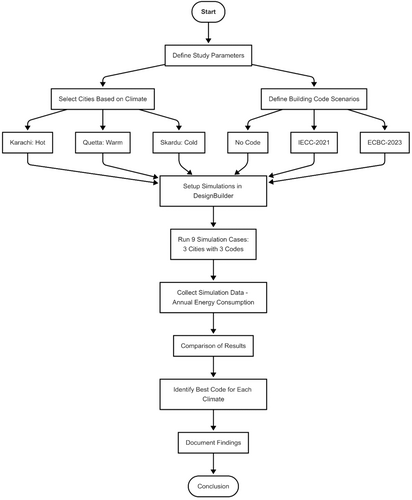
The rest of the paper is as follows. Section 2 presents the data requirements for building energy modeling. The performance analysis of building energy modeling is performed in Section 3, considering the simulation of residential buildings based on compliance with IECC and ECBC. Section 4 discusses the results. The analysis is compared in Section 5. Section 6 concludes the paper with a summary and suggestions for future work.
3 Building Energy Modeling Data Requirements
The software simulates the energy consumption of residential buildings by evaluating a Base Case and a Proposed Case separately. The base case represents the energy consumption of a typical house in Pakistan without any improvements. Contrarily, the proposed case models anticipated performance after implementing energy efficiency measures. The process involves collecting detailed data on weather, schedules, heating, and cooling equipment, building envelope thermal properties, and electrical appliances. The impact of the proposed upgrades (wall and roof insulation, energy-efficient windows, etc.) is analyzed. At the same time, all other parameters, such as lighting and HVAC system schedules, are kept unchanged. This comparison helps identify potential energy savings, guiding users to make informed decisions on the most effective energy efficiency improvements in the envelope for residential buildings.
3.1 Building Typology and Weather Data
A two-story single-family residential building with a covered area of 670 ft2, showcasing a typical residential building in Pakistan, is selected for the current study. Figure 2 shows the detailed house plan and the 3D rendered model of the building, designed with the built-in 3D modeler of the software. Next, the location of the building is selected, and the simulation tool automatically imports the climate zone data relevant to that location. This data includes typical weather patterns (daily solar irradiation, precipitation, and heating and cooling degree days) and seasonal variations crucial for accurate energy performance modeling [22]. If a specific location is not in the database, its EnergyPlus Weather (EPW) file can be acquired from the EnergyPlus or NASA website. In this study, three distinct locations situated in different climate zones across Pakistan were selected. The weather data for these locations can be found in Table 1.
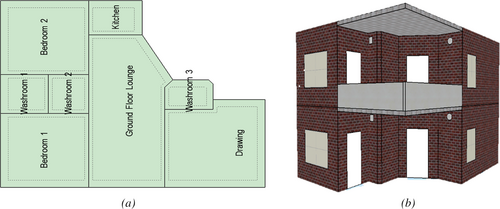
| Location | Climate | Heating degree-days (18°C) | Cooling degree-days (10°C) | Precipitation level | ASHRAE climate zone |
|---|---|---|---|---|---|
| Karachi | Extremely hot | 12.21 | 6087.15 | Low | 0B |
| Quetta | Warm | 1625.74 | 2822.14 | Low | 3B |
| Skardu | Very cold | 6884.85 | 144.66 | Low | 7B |
3.2 Thermal Comfort Design Data
Different activity schedules and indoor design temperatures are crucial for thermal comfort design [24]. This data encompasses occupancy schedules, lighting schedules, equipment usage, and other internal loads (metabolic activity and miscellaneous loads), as shown in Figure 3. It lets users specify detailed schedules and profiles, determining how these elements fluctuate. This information is crucial for simulating buildings to ensure compliance with energy codes and standards, as it accurately reflects the true energy demands and usage patterns expected in practice. The defined schedules directly impact the total energy consumed in a building, as they determine the operational hours and intensity of internal loads. Schedules and temperature configurations selected for the current study are shown in Table 2.

| Temperatures | ||
|---|---|---|
| Description | Base case | Proposed case |
| Temperature—space heating | 22°C | 22°C |
| Heating setback | 12°C | 12°C |
| Temperature—space cooling | 25°C | 25°C |
| Cooling setback | 28°C | 28°C |
The HVAC data allows users to model and configure the heating, ventilation, and air conditioning systems within a building. This includes selecting system types, components, and operational settings. This data also facilitates the simulation of how these systems respond to various internal and external conditions, helping to predict energy consumption, indoor comfort levels, and overall system performance.
Both IECC–2021 (Table C403.3.2(1) Electrically Operated Unitary Air Conditioners and Condensing Units-Minimum Efficiency Requirements) and ECBC–2023 (Table 8-3 Air Conditioners and Condensing Units, Section 8.9.1 Equipment Selection–Minimum Equipment Efficiencies) set minimum efficiency requirements for HVAC systems. These standards are based on the value of the seasonal energy efficiency ratio (SEER). Table 3 presents the HVAC equipment types and their heating and cooling efficiencies. The same HVAC equipment is used in both the base and proposed cases, that is, Package Terminal Air Conditioning with Electric Heating, and they have the same efficiencies (Coefficient of Performance or COP).
| System type | Purpose | Energy source | Efficiency (COP) (base and proposed case) |
|---|---|---|---|
| PTAC with electric heating | Cooling | Electricity | 3.5 |
| Heating | Electricity | 3.00 |
3.3 Lighting
Lighting contributes to a building's cooling load while significantly impacting its electricity consumption. Although installing shading devices reduces the heat entering the building, it can lead to increased energy consumption in buildings due to the reduced natural light, necessitating artificial lighting [25]. Building lighting is typically assessed using Lighting Power Density or LPD in W/ft2. The IECC–2021 and ECBC–2023 establish minimum lighting power allowances for interior lighting expressed in W/ft2. The IECC–2021 specifies a minimum power allowance of 0.65 W/ft2 for residential buildings, while ECBC–2023 sets it at 0.71 W/ft2, as depicted in Figure 4.
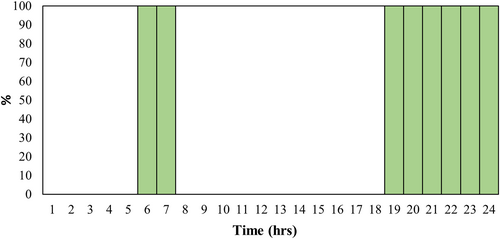
3.4 Building Envelope—Base Case Construction
Base case construction or traditional construction is not energy efficient. Such buildings lack roof and wall insulation and poorly glazed windows. This type of construction is very common in Pakistan, leading to very high-energy consumption in buildings [26]. Additionally, these buildings do not comply with any energy conservation code or regulation. Due to the high U-value of the building envelope, they consume more energy to create indoor thermal comfort. Conversely, the proposed case construction, adhering to the provisions of ECBC–2023 and IECC–2021, will be compared with the base case construction to analyze the energy savings and reduction in carbon emissions. Table 4 shows the building envelope characteristics for base case construction (construction that does not adhere to any energy conservation code).
| External walls | |||
|---|---|---|---|
| Construction material | Layer | Thickness (in) | U-value–nominal (W/m2 K) |
| Cement plaster | 1 | 0.5 | 1.913 |
| Clay bricks | 2 | 9 | |
| Cement plaster | 3 | 0.5 | |
| Roof | |||
| Marble (White) | 1 | 1 | |
| Bitumen (finishing layer) | 2 | 0.4 | 3.593 |
| Concrete slab | 3 | 6 | |
| Cement plaster | 4 | 0.5 | |
| Windows | |||
| Glazing type | U-value (W/m2 K) | Solar heat gain coefficient (SHGC) value | |
| Single glazing (Clr 3 mm) | 5.894 | 0.861 | |
4 Performance Analysis
4.1 Building Energy Simulation for Proposed Case 1 (ECBC—Compliant Building Envelope)
Table 4 highlights that Pakistan's traditional or current construction practices are not energy efficient, as evidenced by the building envelope U-values. Higher U-values indicate poor thermal performance, meaning that building envelope components absorb heat during the day and release it at night, increasing energy consumption in buildings [27, 28]. Proposed Case 1 involves construction that complies with the standards outlined in Pakistani regulation, Energy Conservation Building Code (ECBC—2023). ECBC–2023 is a prescriptive code. The prescriptive approach requires builders to adhere to specific requirements set by the code, including minimum insulation levels, window performance standards, and maximum lighting power densities (LPD) for various building types. Moreover, the code sets a single U-value requirement for building envelope components across all the climate zones, disregarding the diverse climatic conditions of Pakistan [29]. Since the study focused on the impact of building envelope improvements, all other factors, such as activity, lighting, and HVAC, were consistent with those used in the building energy simulation for base case construction. The construction specifications were updated to meet the U-value requirements of ECBC—2023.
4.1.1 ECBC–Compliant Building Envelope
ECBC–2023 sets specific thermal transmittance (U-values) requirements for roofs, walls, and windows. These components remain exposed to direct sunlight and are the primary sources of heat gain in buildings, thereby increasing the load on the cooling systems. In cold areas, where indoor spaces are heated using electricity or gas, it is important to retain the heat inside and minimize heat loss. Thermal transmittance or U-values determine the amount of heat a building gains. The smaller the U-value, the smaller the heat the building gains, and vice versa. ECBC–2023 mandates a U-value of 0.57 W/m2 K for external walls and a U-value of 0.44 W/m2 K for roofs. However, traditional construction materials cannot achieve these thermal transmittance values alone. To meet these standards, walls, and roofs must be insulated with suitable insulating materials [30]. These materials significantly reduce the heat gained or lost by a building [31-33]. The U-values required by ECBC–2023 and the corresponding insulation thickness needed to achieve them are detailed in Table 5.
| Parameter | ECBC–2023 standard | Measure to meet the standard |
|---|---|---|
| External Walls thermal transmittance (W/m2 K) | 0.57 | 1.65 in XPS insulation |
| Roof thermal transmittance (W/m2 K) | 0.44 | 2.7 in XPS insulation |
| Windows thermal transmittance (W/m2 K) |
3.5 (WWR < 40%) 2.5 (WWR > 40%) |
Double-glazed windows with air or argon-filled center. |
XPS (extruded polystyrene), commonly called Jumbolon in Pakistan, is the only readily available insulation material. DesignBuilder has a comprehensive database that offers a selection of different construction and insulation materials. XPS insulation of the thickness specified in Table 5 was applied to the model residential house in the simulation software, which allowed for achieving the U-value mandated by ECBC–2023. The insulation was used as an extra layer alongside the traditional construction materials shown in Table 4. Similarly, the glass type used was “Dbl Clr 3 mm/6 mm Air,” indicating a 3 mm thick glass with a 6 mm air gap that acts as a heat transfer barrier. The thermal properties of XPS insulation and glass are given in Table 6.
| Thermal properties of XPS insulation | |
| Thermal conductivity (W/m K) | 0.034 |
| Specific heat (J/Kg-K) | 1400 |
| Density (Kg/m3) | 35 |
| Thermal properties of glass | |
| Total solar transmission (SHGC) | 0.762 |
| Direct solar transmission | 0.705 |
| Visible light transmission | 812 |
| U-value | 3.159 |
4.2 Building Energy Simulation for Proposed Case 2 (IECC–Compliant Building Envelope)
The International Energy Conservation Code (IECC–2021), developed by the International Code Council (ICC), is a comprehensive framework widely adopted by different countries worldwide, setting standards for energy-efficient design, construction, and operation of residential and commercial buildings. IECC–2021 addresses multiple aspects of building design, including the HVAC systems, lighting, building envelope, renewable energy integration, and water heating, to reduce energy consumption and enhance the sustainability of buildings. The pertinent feature of IECC–2021 is its adaptability to various environmental conditions, setting specific standards for each climate zone. For instance, IECC requires higher insulation levels in colder climates to reduce heating demands. IECC focuses on higher cooling equipment efficiencies, high-performance windows, and passive design strategies for hotter climates to reduce heat gain. Moreover, the code offers prescriptive and performance-based compliance pathways, offering flexibility in achieving energy efficiency and sustainability in building design and construction. For example, in Climate Zone 5, the IECC–2021 requires roofs with a minimum insulation level R-30 and windows to maintain a U-factor of 0.32 or lower. However, if a building in Climate Zone 5 opts for roof insulation of R-20, which is less than the prescriptive R-30, The performance-based approach allows compliance by offsetting lower insulation with energy-saving measures like high-efficiency HVAC systems or advanced LED lighting with smart controls that significantly reduce energy consumption. Compliance under the performance-based approach is achieved if the building's total energy consumption meets or falls below the level prescribed by code requirements.
4.2.1 IECC–Compliant Building Envelope
The IECC–2021 mandates specific thermal transmittance (U-values) for buildings based on the climate zones. This work selected only Skardu, Quetta, and Karachi, which have different climatic conditions. Karachi is included in climate zone 0B, characterized as Hot and Dry. Quetta falls within climate zone 3B, which is warm and dry, while Skardu, located in climate zone 7B, has very cold and dry conditions. As per IECC, higher insulation levels are required for buildings in cold climates compared to hot climates. This is primarily due to colder climates' greater temperature difference between the exterior and interior. Moreover, colder regions experience long and harsh winters, requiring more heating energy for indoor thermal comfort and hot water supply. Consequently, buildings in colder climates offer more energy-saving potential than buildings in hotter climates [31]. Table 7 presents the U-value standards for the building envelope as prescribed by IECC–2021 and the measures needed to be implemented to meet these standards.
| Parameter | Location/climate zone | IECC–2021 standard | Measure to achieve the standard |
|---|---|---|---|
| External Walls thermal transmittance (W/m2 K) | Karachi—0B | 0.86 | 0.862 in XPS insulation |
| Quetta—3B | 0.60 | 1.567 in XPS insulation | |
| Skardu—7B | 0.40 | 2.621 in XPS insulation | |
| Roof thermal transmittance (W/m2 K) | Karachi—0B | 0.22 | 5.713 in XPS insulation |
| Quetta—3B | 0.22 | 5.713 in XPS insulation | |
| Skardu—7B | 0.159 | 8.047 in XPS insulation | |
| Windows thermal transmittance (W/m2 K) | Karachi—0B | 3.5 | Double-glazed Clr 3 mm/6 mm Air |
| Quetta—3B | 3.06 | Double-glazed Clr 3 mm/13 mm Air | |
| Skardu—7B | 2.04 | Triple glazed Clr 3 mm/30 mm Air |
5 Results and Discussion
5.1 Building Energy Performance for Traditional Construction
The study compared the energy-saving potential of the Pakistani Energy Conservation Building Code (ECBC–2023) and the International Energy Conservation Code (IECC–2021). The results were derived from the simulation using the input data outlined in Section 3 for base case construction and Sections 4 and 5 for ECBC-compliant and IECC-compliant constructions, respectively. The study focused on the impact of building envelope improvements in a single-family residential building with a covered area of 670 ft2 in three different climate zones of Pakistan.
Figure 5 shows the annual energy consumption for different locations or climate zones. These results indicate that buildings in colder climates consume more energy (20,042 kWh in climate zone 7B) than buildings in hotter climates (8348 kWh in climate zone 0B and 8758 kWh in climate 3B), primarily due to high heating demands during harsh and long winters. Although this presents a challenge, it also highlights the greater potential for energy savings. For climate zone 0B, cooling demand accounted for a significant 87.22% (7281 kWh) of the building's total energy consumption, while interior lighting and fans combined consumed 11.3% (940.68 kWh) of the total energy. On the other hand, in climate zone 7B, 94% (18837.78 kWh) was consumed for heating applications. Such high cooling and heating demands stem from using traditional building construction materials. These findings underscore the direct need for improvements in the building envelopes as well as innovation and research to enhance the efficiencies of heating and cooling equipment. The energy usage intensity (EUI), which measures the energy consumption per unit of building area, was calculated to be 12.46 kWh/ft2 for climate zone 0B and 13 and 29.9 kWh/ft2 for climate zones 3B and 7B, respectively. The EUI is a key metric that assesses and compares the energy efficiency of buildings.
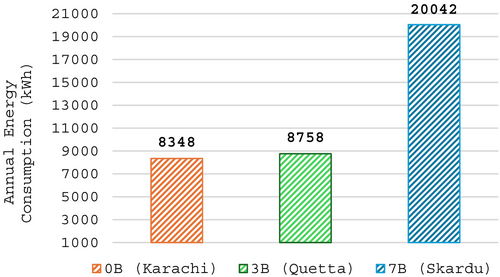
5.2 Energy Performance of ECBC–Compliant Building Envelope
ECBC–compliant building envelopes adhere to the standards set by ECBC–2023. Buildings that meet these standards demonstrated reduced energy consumption compared to the base case construction. Traditional construction materials have a higher tendency to absorb and radiate heat, leading to increased energy demands for heating and cooling. However, applying insulation to roofs and walls significantly reduces heat transfer between the interior and exterior environments. This enhanced thermal performance minimizes energy loss and improves indoor comfort, contributing to overall energy efficiency in buildings.
Figure 6 illustrates the annual energy consumption of ECBC-compliant model building. Energy consumption in climate zone 0B was reduced to 6338 kWh, showing 24% energy savings. In climate zone 3B, the annual consumption dropped to 4791 from 8758 kWh, reflecting energy savings of 45.3%. Similarly, in climate zone 7B, the annual energy consumption was reduced to 13,255 kWh, down from 20,042 kWh, achieving 33.86% energy savings. The cooling demand in climate zone 0B decreased to 5458.35 kWh, reflecting a 25% reduction, while the heating demand in climate zone 7B dropped to 12186.3 kWh, showing a decrease of 35.31%. The EUIs of the ECBC-compliant buildings reduced to 9.46, 7.15, and 19.78 kWh/ft2 for climate zones 0B, 3B, and 7B, respectively.
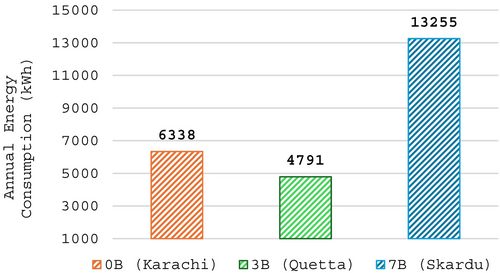
5.3 Energy Performance of IECC–Compliant Building Envelope
The International Energy Conservation Code (IECC–2021) offers higher flexibility as it incorporates both prescriptive and performance-based approaches to reduce energy consumption in buildings. This flexibility allows builders to follow specific guidelines or demonstrate that their building performance meets energy efficiency goals. However, in this study, we have focused exclusively on the prescriptive aspects of the code. The energy efficiency measures in Table 7 ensure buildings comply with IECC's requirements. In addition to these measures, the IECC–2021 also emphasizes using advanced controls, such as programmable thermostats, daylighting controls, and occupancy sensors, which optimize energy use by adjusting heating, cooling, and daylighting conditions based on occupancy. Figure 7 depicts the annual energy consumption of the IECC–compliant model building. Upon adherence to the standards of IECC–2021, the annual energy consumption was reduced to 6528 kWh in climate zone 0B. In climate zones 3B and 7B, the annual energy consumption decreased to 4614 and 4107 kWh. In terms of percentage reduction, energy consumption dropped by 21.8% in climate zone 0B, by 47.32% in climate zone 3B, and by 79.5% in climate zone 7B. The EUI values were 9.74 kWh/ft2 for climate zone 0B, 6.89 kWh/ft2 for climate zone 3B, and 6.13 kWh/ft2 for climate zone 7B. The cooling demand in climate zone 0B decreased to 5623.71 kWh, while the heating demand in climate zone 7B dropped to 1532 kWh.

6 Comparative Analysis
This section compares the energy-saving potential of ECBC–2023 and IECC–2021. By analyzing the performance of buildings designed according to each code, we aim to determine which standards offer greater energy consumption reduction across different climate zones. The comparison will also help understand and enhance the effectiveness of ECBC–2023, particularly in Pakistan, and assess its suitability alongside the more established IECC–2021 standards. This comparison is new since ECBC–2023 is relatively new, and understanding its effectiveness is key to its adoption in Pakistan.
Figure 8 compares the annual energy consumption of the model building when it complies with ECBC–2023 and IECC–2021 against that of the traditional building in climate zone 0B. In hot climates such as Karachi, the implementation of ECBC–2023 resulted in a 24% reduction in annual energy consumption, while compliance with IECC–2021 led to a 21.8% reduction. This indicates that ECBC outperforms IECC–2021 in hot climates. This difference in performance can be linked to the U-value standards specified by both codes, as shown in Table 8. ECBC sets a U-value of 0.44 W/m2 K for the roof, whereas IECC–2021 prescribes a U-value of 0.22 W/m2 K. While the IECC's roof U-value standard is more stringent, the lower U-value standard of ECBC protects better against heat gain, which is particularly important in hot climates, where walls remain exposed to direct sunlight all day. This explains why ECBC–2023 performs better than IECC–2021 in such environments.
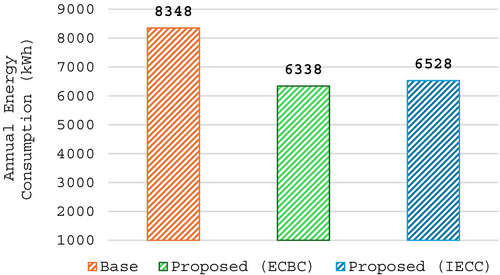
| Parameter | ECBC standard | IECC–2021 standard |
|---|---|---|
| Roof thermal transmittance (W/m2 K) | 0.44 | 0.22 |
| Wall thermal transmittance (W/m2 K) | 0.57 | 0.86 |
| Window thermal transmittance (W/m2 K) | 3.5 | 3.5 |
Figures 9 and 10 illustrate that in warm and very cold climates (climate zones 3B and 7B), IECC–2021 demonstrates greater energy-saving potential than ECBC–2023. In climate zone 3B, ECBC achieved energy savings of 45.3%, while IECC–2021 slightly outperformed it with savings of 47.32%. The difference is more pronounced in very cold climates, with the ECBC-compliant model building achieving 33.86% energy savings, compared to a significant 79.5% reduction demonstrated by the IECC-compliant model. This substantial difference in very cold climates can be attributed to the stricter U-value requirements of IECC–2021, as shown in Table 9.
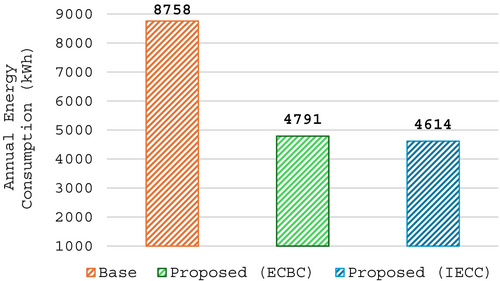
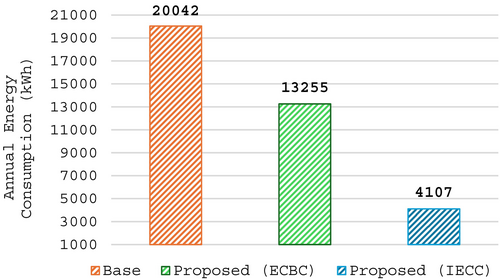
| Parameter | ECBC standard | IECC–2021 standard |
|---|---|---|
| Roof thermal transmittance (W/m2 K) | 0.44 | 0.159 |
| Wall thermal transmittance (W/m2 K) | 0.57 | 0.4 |
| Window thermal transmittance (W/m2 K) | 3.5 | 2.04 |
The IECC–2021 is designed with the climatic conditions in mind, where many states experience very low temperatures, making heating load a critical concern. In contrast, 70% of Pakistan falls within hot and warm climate zones, where the national grid's cooling demands are a primary concern.
7 Conclusions
In Pakistan, the surge in population and inadequate urban planning have significantly increased energy demand. The building sector accounts for nearly half of total energy consumption, and addressing this challenge necessitates the integration of renewable energy generation and implementing energy-efficient measures in the existing buildings or construction sector of Pakistan. In this regard, this work emphasized improving the energy efficiency of buildings to reduce the energy demand. Pakistan introduced its first Energy Conservation Building Code to address this challenge in 2023 and compared it with the International Energy Conservation Code−2021. In hot climates, Energy Conservation Building Code–2023 achieved 24% energy savings for a single-family residential building, with its best performance in warm climates, delivering 45% energy savings. In very cold climates, the Energy Conservation Building Code−2023 resulted in a 33% reduction in energy consumption. Conversely, the International Energy Conservation Code−2021 demonstrated superior performance in cold climates, achieving 79.5% energy savings. In hot and warm climates, the International Energy Conservation Code–2021 reduced the annual energy consumption by 21% and 47%, respectively. Given that 70% of Pakistan is classified as hot, with frequent heat peak loads and power outages during summer due to excessive energy consumption for cooling, the Energy Conservation Building Code−2023 will focus on reducing heat gain. The effectiveness of the Energy Conservation Building Code−2023 will be further enhanced by prioritizing strategies to minimize heat gain, which is crucial for alleviating the stress on the national grid during the summer months.
Author Contributions
Muhammad Osama Aziz: conceptualization, software, writing – original draft. Muhammad Abbas: methodology, software, writing – original draft. Fakhre Alam Khan: conceptualization, supervision, writing – review and editing. Naveed Ahmad: supervision, writing – review and editing, validation. Fazli Yazdan: formal analysis, data curation, project administration. Hamad Aftab: investigation, writing – original draft, visualization. Mohammad Irshad Khan: project administration, resources, supervision. Zahid Ullah: resources, investigation, writing – review and editing.
Acknowledgments
This work is part of the project “Transformation of the Construction Sector in Pakistan: A Pathway Towards Clean, Green and Sustainable Buildings” supported by GIZ Pakistan (Deutsche Gesellschaft für Internationale Zusammenarbeit) and funded by the German Federal Ministry for Economic Cooperation and Development (BMZ). Open access publishing facilitated by Politecnico di Milano, as part of the Wiley - CRUI-CARE agreement.
Conflicts of Interest
The authors declare no conflicts of interest.
Open Research
Data Availability Statement
The data that support the findings of this study are available from the corresponding author upon reasonable request.



